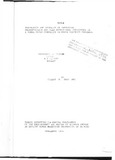| dc.contributor.author | Swai, CW | |
| dc.date.accessioned | 2013-05-12T09:01:04Z | |
| dc.date.available | 2013-05-12T09:01:04Z | |
| dc.date.issued | 1994 | |
| dc.identifier.citation | Master of Science in Applied Human Nutrition | en |
| dc.identifier.uri | http://erepository.uonbi.ac.ke:8080/xmlui/handle/123456789/22336 | |
| dc.description.abstract | A cross-sectional study was carried out from June to
November 1991 in three rural child communities, 2-10 years
of age in Mbeya district, Tanzania. This study was to
determine the prevalence of intestinal parasites and its
association with nutritional status. Six hundred and eight
children from 402 households were randomly sampled from
the three rural villages, from which social demographic
Information was obtained and stool examined for
parasites. The nutritional status was assessed through
anthropometry and haemoglobin estimation. Confounding
factors like malarial parasitaemia were studied. The
overall prevalence of intestinal parasites was 10.7%.
There was no significant relation between nutritional
status (measured by wt/ht) and the worm loads in this
child population, however an association existed between
children's worm load and their haemoglobin level; whereby
the higher the worm load the lower the haemoglobin level | en |
| dc.language.iso | en | en |
| dc.publisher | University of Nairobi | en |
| dc.title | Prevalence and severity of intestinal helminthiasis and some nutritional indicators in a rural child community in Mbeya District Tanzania | en |
| dc.type | Thesis | en |
| local.publisher | Department of Food and Nutrition Technology | en |

